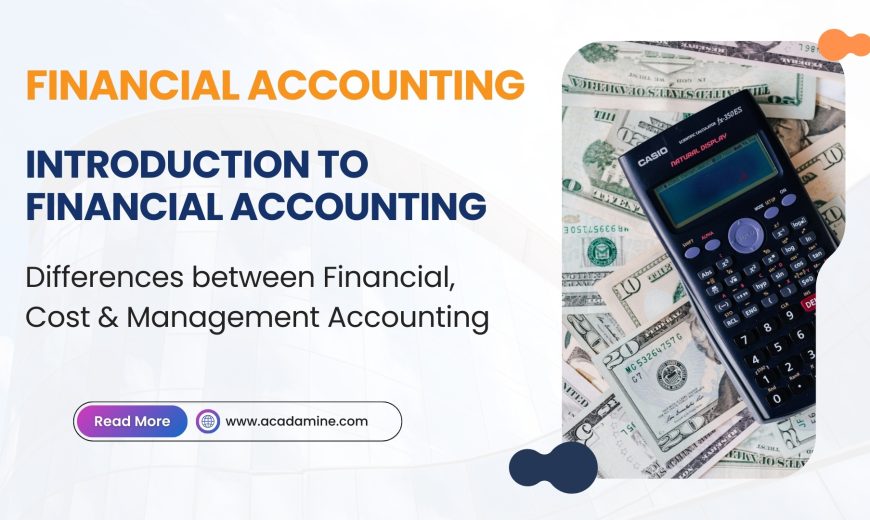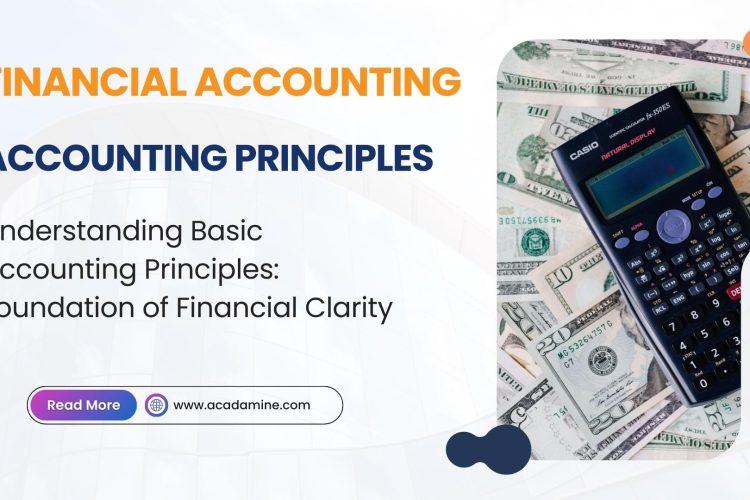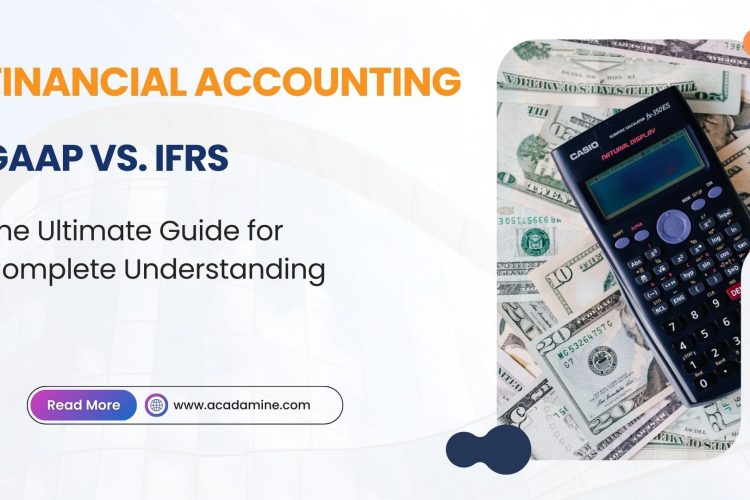
With dyneming business environment, accounting is also expanding. So it is further sub-divided into financial, cost, and management accounting to address the diverse needs of stakeholders and to provide tailored information for different purposes. Here are the key reasons for this division:
Difference between Financial & Cost Accounting

Definition of Finacial Accounting
Accounting is the art of recording, classifying and summarizing in a significant manner and in terms of money, transactions, and events which are, in part at least, of a financial character, and interpreting the results thereof.
~American Institute of Certified Public Accountants (AICPA)
Definition of Cost Accounting
Application of costing and cost accounting principles, methods and techniques to the science, art and practice of cost control and the ascertainment of profitability as well as the presentation of information for the purpose of managerial decision-making.
~Chartered Institute of Management Accountants (CIMA)
| Aspects | Financial Accounting | Cost Accounting |
|---|---|---|
| Purpose | Focuses on preparing financial statements for external stakeholders such as investors, creditors, and regulators. | Focuses on determining the cost of production and operations for internal management decisions. |
| Audience | External stakeholders (e.g., shareholders, creditors, government authorities). | Internal management for planning, controlling, and decision-making. |
| Regulation | Governed by standardized rules like GAAP or IFRS. | Not governed by formal rules; tailored to internal requirements. |
| Scope | Covers the entire financial position of an organization (income, expenses, assets, and liabilities). | Primarily focuses on analyzing costs related to production, operations, or processes. |
| Reporting Frequency | Prepared periodically (e.g., annually, quarterly). | Prepared as needed, often more frequently, like monthly or weekly. |
| Content | Summarizes financial performance and position. | Provides detailed cost data, including per-unit costs, variances, and efficiency metrics. |
| Focus | Emphasis on profitability and overall financial health. | Emphasis on cost control, efficiency, and budgeting. |
| Valuation Basis | Uses historical data and actual transactions. | Uses historical, estimated, and standard costs to assess and control future costs. |
| Confidentiality | Shared publicly with stakeholders. | Confidential and restricted to internal management. |
| Decision Support | Limited in providing specific operational insights for internal decision-making. | Aims to support detailed operational and strategic decisions. |
Conclusion:
Financial accounting primarily serves external needs by offering a broad overview of financial health, while cost accounting is an internal tool for detailed cost analysis and operational efficiency.
Difference between Financial & Management Accounting
Definition of Finacial Accounting
Accounting is the art of recording, classifying and summarizing in a significant manner and in terms of money, transactions, and events which are, in part at least, of a financial character, and interpreting the results thereof.
~American Institute of Certified Public Accountants (AICPA)
Definition of Management Accounting
Management accounting is the sourcing, analysis, communication, and use of decision-relevant financial and non-financial information to generate and preserve value for organizations.
~Chartered Institute of Management Accountants (CIMA)
| Aspects | Financial Accounting | Management Accounting |
|---|---|---|
| Purpose | Provides financial information to external stakeholders for reporting and compliance. | Provides detailed information to internal management for decision-making and strategic planning. |
| Users | External stakeholders such as investors, creditors, regulators, and shareholders. | Internal stakeholders like managers, executives, and decision-makers. |
| Scope | Focuses on the overall financial performance and position of the organization. | Focuses on internal operations, efficiency, and strategy. |
| Regulation | Governed by standards like GAAP or IFRS; requires compliance with legal and regulatory frameworks. | Not governed by formal rules; highly flexible and tailored to the organization’s needs. |
| Time Orientation | Historical, summarizing past financial transactions. | Forward-looking, emphasizing planning, forecasting, and decision-making. |
| Reports | Produces formal financial statements (income statement, balance sheet, cash flow statement). | Produces various internal reports such as budgets, forecasts, variance analyses, and performance reviews. |
| Detail Level | Focuses on aggregated, company-wide data. | Provides detailed, segment-specific or project-specific data. |
| Confidentiality | Publicly shared and accessible to external parties. | Confidential and restricted to internal management. |
| Decision Support | Limited in aiding internal decision-making; focuses on financial reporting. | Designed to support strategic and operational decisions. |
| Nature | Quantitative, based on actual financial transactions. | Both quantitative and qualitative, integrating non-financial data like market trends and employee performance. |
Conclusion
Financial Accounting focuses on providing standardized, historical financial information to external users while Management Accounting is an internal tool that supports strategic, operational, and forward-looking decision-making.
Difference between Cost & Management Accounting
Definition of Cost Accounting
Application of costing and cost accounting principles, methods and techniques to the science, art and practice of cost control and the ascertainment of profitability as well as the presentation of information for the purpose of managerial decision-making.
~Chartered Institute of Management Accountants (CIMA)
Definition of Management Accounting
Management accounting is the sourcing, analysis, communication, and use of decision-relevant financial and non-financial information to generate and preserve value for organizations.
~Chartered Institute of Management Accountants (CIMA)
| Aspects | Cost Accounting | Management Accounting |
|---|---|---|
| Purpose | Focuses on tracking, analyzing, and controlling costs of production or operations. | Aims to provide comprehensive financial and non-financial information for decision-making and strategic planning. |
| Scope | Deals specifically with cost-related data, such as cost allocation, cost control, and cost reduction. | Broader scope, covering all aspects of financial and operational data for managerial use. |
| Data Focus | Primarily focuses on historical cost data and predetermined costs like standard costing. | Combines historical data, budgets, forecasts, and non-financial information for planning and decision-making. |
| Users | Primarily serves cost accountants and production managers. | Focuses on serving senior managers and executives for strategic decision-making. |
| Regulation | Governed by costing methods and techniques, but less flexible than management accounting. | Not governed by any formal regulations; highly flexible and tailored to organizational needs. |
| Reports | Produces detailed cost reports, like cost sheets and variance analyses. | Produces a variety of reports, including performance analysis, budget variance, and strategic reviews. |
| Decision Support | Supports decisions related to cost control, pricing, and cost optimization. | Aids in broader managerial decisions, including planning, strategy, investment, and performance evaluation. |
| Nature | Analytical and operational, focusing on the “how much” and “how efficiently” aspects of costs. | Comprehensive and forward-looking, focusing on “why,” “what if,” and “how to improve” scenarios. |
| Integration | Operates independently of other management functions. | Integrates with other functions like marketing, production, and human resources for holistic management. |
| Time Orientation | Primarily historical and short-term in focus. | Both historical and forward-looking, with an emphasis on long-term strategic goals. |
Conclusion
Cost Accounting is a subset of management accounting, focusing specifically on costs, while management accounting has a broader perspective, emphasizing the overall performance, strategy, and management of the organization.
Differences between Financial, Cost & Management Accounting

Definition of Finacial Accounting
Accounting is the art of recording, classifying and summarizing in a significant manner and in terms of money, transactions, and events which are, in part at least, of a financial character, and interpreting the results thereof.
~American Institute of Certified Public Accountants (AICPA)
Definition of Cost Accounting
Application of costing and cost accounting principles, methods and techniques to the science, art and practice of cost control and the ascertainment of profitability as well as the presentation of information for the purpose of managerial decision-making.
~Chartered Institute of Management Accountants (CIMA)
Definition of Management Accounting
Management accounting is the sourcing, analysis, communication, and use of decision-relevant financial and non-financial information to generate and preserve value for organizations.
~Chartered Institute of Management Accountants (CIMA)
| Aspects | Financial Accounting | Cost Accounting | Management Accounting |
|---|---|---|---|
| Purpose | Provides financial information to external stakeholders for reporting and compliance. | Tracks, analyzes, and controls production or operational costs. | Offers detailed financial and non-financial information to aid internal decision-making and strategic planning. |
| Users | External Stakeholders (e.g., investors, creditors, regulators). | Primarily internal stakeholders like cost accountants and production managers. | Internal management, including senior executives and decision-makers. |
| Scope | Covers the entire organization’s financial health (assets, liabilities, income, and expenses). | Focuses on specific cost-related aspects like cost allocation, reduction, and control. | Broader scope that includes financial, cost, operational, and strategic data. |
| Regulation | Governed by strict rules like GAAP, IFRS, or local accounting standards. | Follows specific costing methods and techniques but lacks external regulation. | Not governed by formal rules; flexible and customized to organizational needs. |
| Reports | Produces financial statements like balance sheets, income statements, and cash flow statements. | Produces cost-related reports, such as cost sheets, process costing, and variance analysis. | Produces a variety of reports, including budgets, forecasts, performance evaluations, and strategy reviews. |
| Focus | Emphasizes profitability and overall financial health. | Emphasizes cost control, efficiency, and pricing decisions. | Focuses on improving decision-making, strategy, and organizational performance. |
| Time Orientation | Historical in nature, summarizing past financial transactions. | Primarily historical but may include standard and estimated costs for operational planning. | Both historical and forward-looking, incorporating forecasts and strategic plans. |
| Decision Support | Limited to broad financial decisions and external reporting. | Supports operational decisions related to cost efficiency and pricing. | Supports strategic and managerial decisions across the organization. |
| Nature | Quantitative, focused on actual financial transactions and outcomes. | Quantitative, focusing on cost data and efficiency metrics. | Both quantitative and qualitative, integrating various forms of data for comprehensive insights. |
| Audience | Publicly available to external parties like shareholders and regulators. | Confidential and for internal use only. | Highly confidential, intended solely for internal management. |
Conclusion
1) Financial Accounting: Focuses on external reporting and compliance.
2) Cost Accounting: Specializes in cost-related details for operational efficiency.
3) Management Accounting: Combines financial and non-financial data to support internal decision-making and strategic planning.


